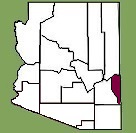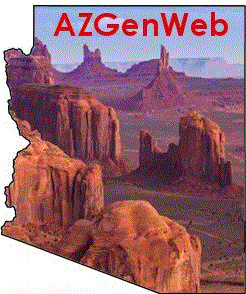1913 Who's Who in Arizona
This book by Jo Conners was published in 1913. A small sampling of extractions are provided below.
- Greenlee County, pages 97-99
- Arizona Copper Company & Shannon Copper Company, pages 138-143
- First National Bank of Clifton, pages 250-253
- Biographies
Arizona Copper Company
Arizona Copper Company, LTD., whose lands consist of about 4,000
acres containing eight producing mines in Greenlee County, was organized in
August, 1884, under the laws of Great Britain, with a capitalization of
755,000. About 20 per cent of this stock is issued in the United States. The
mines, except the Coronado, are developed to a depth of 500 feet only, being
opened mainly by tunnels, thereby affording cheap extraction.
Notwithstanding the comparatively shallow zone of development, a tremendous
amount of ore is in sight. Considerable diamond drilling has been done. The
Humboldt mine, which is the principal producer, shows a large body of
low-grade disseminated chalcocite. Extraction from this property is partly
opencast, but mainly through tunnels equipped with electric lights and
electric traction. The haulage system uses the overhead trolley. Electric
locomotives of 12 horse-power haul 80-ton loads, the line having a single
track running 8,600 feet directly through the mountain, with a loop reaching
all workings of the Humboldt mine, the tunnel running through International
Hill direct to the new concentrator. The Longfellow mine, belonging to this
Company, is the oldest important copper mine in Arizona, dating from about
1877. A 1300-foot tunnel driven from Chase Creek connects with a 600-foot
blind shaft, obviating about three miles of railroad haulage over bad
grades. The Longfellow Extension mine has developed into a good property.
The Coronado Group, about nine miles from Clifton, has three shafts, the
deepest of which is 1,100 feet, and shows considerable high grade ore. Ore
is taken from the different mines by six gravity tramlines to storage bins
on the Coronado railroad, from which it is hauled to the reduction plant at
Clifton. This railroad is of 36-inch gauge from Clifton to Metcalf, a
distance of seven miles, and has 30-ton ore cars.
The mines and works use about 3,000 horse-power, supplied in about equal
portions from steam, gas and distillate engines. The gas-engine plant is
exceptionally complete. It has been planned to develop hydro-electric power
and transmit same from a dam about 50 miles distant. The somewhat scattered
works at Clifton, Morenci, Longfellow and Metcalf were remodeled and
enlarged several times, and the reduction plants now include six
concentrators, a smelter, lixiviation plant and acid plant.
No. 6 Concentrator has a daily capacity of 1 ,500 tons, and has two 600-ton
crushers and a 250 horse-power Nordberg engine, direct connected to a 125
horse-power dynamo, steam being furnished by three 400 horse-power Stirling
water-tube boilers. No. 6 Mill has a large settling basin. The Company has
had trouble over tailings and has found it necessary to use its best
endeavors to keep its tailings from entering the river. There is a tank
about a mile above the town, with an 18-inch wooden pipe line to supply
clear water at flood times, and in dry seasons, the tank being fed by
seepage and spring water.
The smelter is of steel frame with slate roof and floor of iron plates laid
in cement. There are six 300-ton water-jacket blast furnaces, each 39x240
feet at the tuyeres, with blast supplied by Nos. 7, 9 and 10 Connersville
blowers, operated by a 275 horse-power engine. Gases from the blast furnaces
pass through a 480-foot tunnel and 300-foot stack. Matte of 50 to 55 per
cent copper tenor is charged into the converters by a 10-ton ladle handled
by a 30-ton electric crane. The converter plant has three stands and six
7-ton shells, with a daily capacity of 50 tons of 99.5% blister copper.
Disintegration of slag by running water was tried, but has been
discontinued, and molten slag is again handled by a steam locomotive. A
complete new smelter is now under construction.
The 25-ton briquetting plant uses coal-breeze as a binder, under a pressure
of 2,000 pounds per square inch. The plant is entirely automatic, fines
going in at one end and briquettes being loaded on cars at the other.
The acid plant makes about 3,000 tons of sulphuric acid yearly from the
fumes of the roasters, the entire product being used in the leaching plant,
which treats an average of 250 tons of low grade oxidized ore daily. This is
perhaps the most successful leaching plant in the United States.
Miscellaneous enterprises include a well-equipped foundry, machine shop, saw
mill, planing mill, and 20-ton ice plant, all built of brick. The Company
also has excellent general merchandise stores at Clifton, Longfellow and
Metcalf, while a splendid library is maintained for employees. The number of
employees at the present time is over 2,700.
The office of the Company is at 29 St. Andrew Square, Edinburgh, Scotland,
and the mine and works office at Clifton, Arizona. The officers are as
follows: John Wilson, Chairman ; P. Dickson, J. P. G. Readman, J. Wilson, Y.
J. Pentland, Alex McNab, J. P., and Lord Salveson, Directors ; Norman
Carmichael, General Manager ; William Exley Miller, Secretary; George
Fraser, Smelter Superintendent; Archibald Morrison, Mill Superintendent at
Clifton; J. G. Cooper, Purchasing Agent. The Company is entitled to much
credit for its conservatism and the thoroughly successful working of its
plant.
Shannon Copper Co.

Shannon Copper Company's Mines and Smelter
The Shannon Copper Co. was organized November 13, 1899, under the laws of
Delaware, for the purpose of purchasing the Hughes and Shannon mine, which
had been for years considered the equal of any copper mine in Arizona. It
had been owned for twenty years by Charles M. Shannon, the well known
pioneer of the district, who had been unable to interest capital to develop
the property so as to bring it to a producing stage, until he attracted the
attention of Mr. W. B. Thompson, of Boston. Mr. Thompson, however, would not
undertake to handle the property unless it w y as sold outright, which Air.
Shannon agreed to do with the understanding that he be allowed to retain an
interest in the company as stockholder. The company was capitalized at
$3,000,000, par value of shares $10; and in July, 1909, this amount was
increased to $3,300,000, of which $300,000 was held in the treasury for
conversion of an issue of $600,000 6% bonds which had been authorized in
May, 1909, by the Shannon-Arizona Railway Company, and were convertible into
Shannon stock at $20.00. The company also had a direct issue of 7% bonds
originally $600,000 with a $60,000 annual sinking fund for redemption, by
means of which the bond issue was reduced. The new company immediately began
the systematic development of the property, and shortly afterward purchased
some adjoining claims from the Arizona Copper Company, the pioneer mining
company of the district. This gave them not only very valuable mines, but
also control of ground which was necessary in the extensive work which had
been mapped out. Their lands now consist of about 50 claims, in area about
400 acres, at Metcalf, in the Greenlee district, with a millsite of about
100 acres area, and some limestone claims on the Frisco River. The mine is
developed by shafts, tunnels and open pits, underground workings reaching a
depth of about 1,300 feet below the crest of the mountain. The mine is
timbered with 12x12" square sets. Extraction is by two double track tunnels,
one of which is 7x8' in size and connects with a 1,400' double-track incline
tram leading to the Coronado Railway, with six ore-bins at either end, the
tramway, inclined at 36 deg., having 10-ton cars operating in
counter-balance with a retarding engine at the upper end, the steel cable
passing around a 13' double drum, which runs a small air-compressor that
generates power while serving as an auxiliary brake. The Shannon Company
controls the Coronado Mining Co., through ownership of 51%, of the stock
issue, and operates under lease, the property of the Leonard Copper Company,
owning the Copper Belle mine at Gleeson. They also own and operate the
Shannon-Arizona Railway, which is capitalized at $600, 000. This
standard-gauge line of about ten miles length, was built and equipped at a
cost of about $600,000, the territory traversed being very rugged and a
900-foot tunnel having been necessary. It was completed in 1910, and has not
only proven a saving to the company of considerable money on ore haulage,
but gives immunity from the serious interferences formerly caused by annual
floods.
The 1,000-ton smelter at Clifton, seven miles from the mines, had two
350-ton water-jacket blast-furnaces, which were thrown into one large
furnace by a new section between, built on the plan first used at the Washoe
works, making a single blast-furnace of 1,000 tons daily capacity. The
briquetting plant for flue dust and fines has a daily capacity of 60 tons,
and there is a small sampling mill in connection. The 500-ton concentrator,
on the San Francisco River, eight miles from the mine, has ore bins 100'
long, in two sections, for first and second grade ores, and treats daily
about 400 tons of ore.. Tailings have carried as high as 1.2% copper, due to
the highly oxidized condition of ores, but have been stored and may be
leached later. Formerly there was much trouble from acid waters eating the
iron screens, while brass or copper screens in the jigs were worn out too
rapidly by abrasion. This trouble was overcome by a simple but ingenious
application of the principle of electrolysis, a low-voltage electric current
being applied to the jigs, by which the screen became a cathode in the
circuit, this attracting hydrogen from the water, which in turn, attracts
the metallic salts, and the copper freed is deposited on that portion of the
screens formerly eaten away. Water is pumped from wells near the San
Francisco River by an electric triplex pump. The amount of ore smelted has
shown an unbroken annual increase since the fiscal year 1904, while costs
have also shown improvement The office of the company is at No. 82
Devonshire Street, Boston, Mass., the mine office at Metcalf, Arizona, and
the works office at Clifton, Arizona. The officers are: Nathan L. Amster,
president; Alexander B. Clough, vice president; David A. Ellis, secretary;
R. Townsend McKeever, treasurer; Charles R. Jeffers, assistant secretary and
treasurer; John W. Bennie, general manager; H. H. Dyer, general
superintendent; H. A. Collin, mine superintendent; William H. Bond, mill
superintendent. The stock of the company is listed on the Boston Stock
Exchange, the property is considered very valuable, and the management
excellent.




